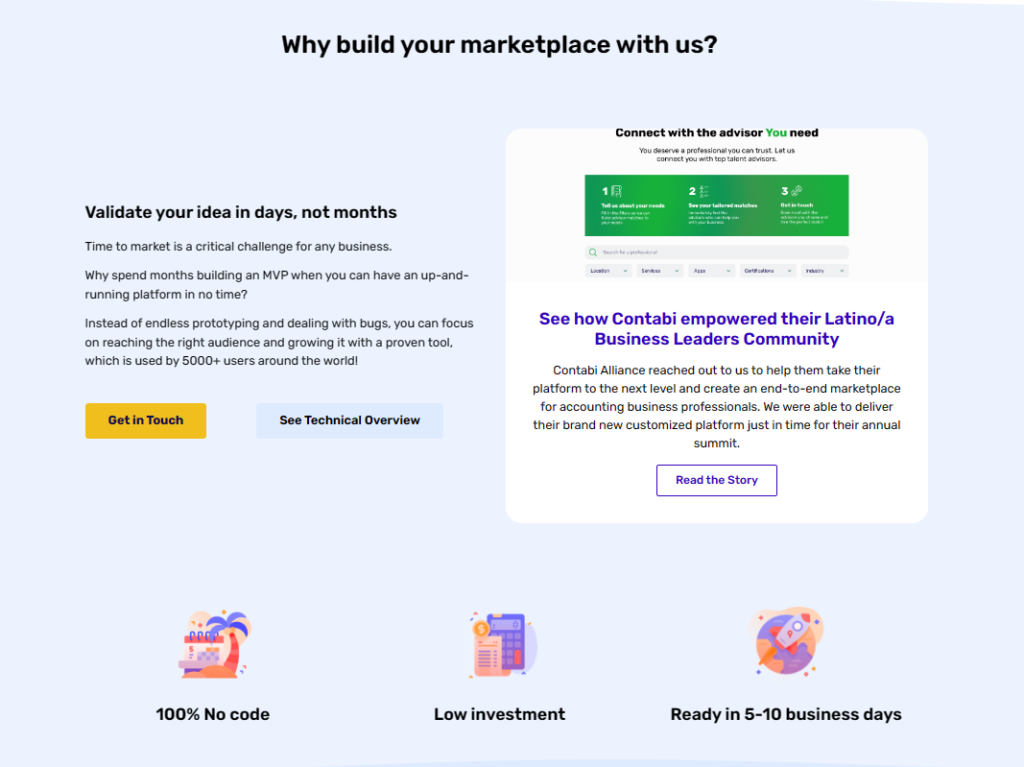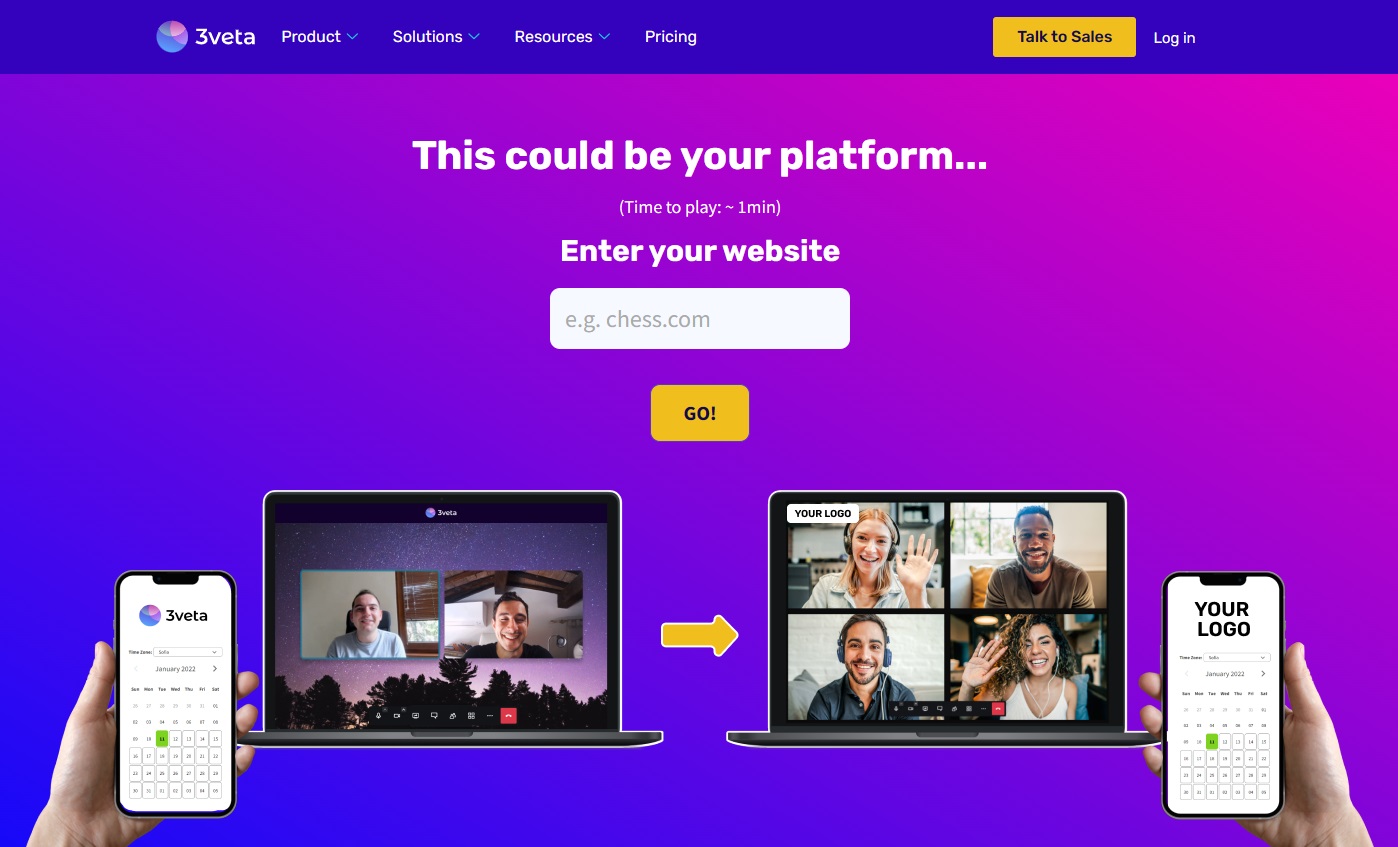Launching a services marketplace is not rocket science at all, once you’ve got a solid idea for your business.
Figuring out what type of professional services marketplace you’d like to create and what your business model would look like is essential, but what do you do once you feel ready to kick off?
Instead of going head-first into the deep waters of building a sophisticated marketplace right away, we advise you to start with MVP testing.
But what is MVP, why is it beneficial, and how do you build one? Find out in the sections below.
What is MVP?
MVP stands for Minimum Viable Product and is a product development strategy where you create a simplified version of your business idea with just the most essential features.
To picture it better, imagine that you’re making a cake. You start with the most basic ingredients, like flour, eggs, and sugar, and then add in just enough other ingredients to make it taste good, like vanilla extract or chocolate chips.
You don’t go crazy and add every possible ingredient you can think of, because that would be too expensive and time-consuming.
Once you have your basic cake, you bake it and then share it with your friends and family to see if they like it.
If they do, great! You can start adding more ingredients and making it even better. But if they don’t, you can go back to the drawing board and figure out what went wrong.
In the same way, with MVP testing, you create a basic version of your product with just the essential platform features and then share it with a small group of users to see if they like it.

This whole process is called idea validation.
The key is to get your services marketplace out there quickly and test it with real users, so you can gather feedback and make informed decisions about how to develop it further.
This way, you minimize risk and uncertainty and increase your chances of success.
Why MVP testing is important?
There are many reasons why you should definitely build an MVP before fully investing your time and resources into your marketplace idea.
First and foremost, it minimizes risk and uncertainty. Creating an MVP allows you to test your product idea in a real-world setting and gather feedback from actual users.
This way you identify potential problems and challenges early on, before investing too much into a product that may not be successful.
Also, MVP testing saves time and money because it prompts you to focus on the most important features of your product, without distracting yourself with unnecessary features that may not add much value. This can help you launch your product faster and at a lower cost.
Naturally, it also helps you make data-driven decisions because you can gather valuable feedback and data on how people use and interact with your product. This can inform you on how to improve and evolve your product based on user needs and preferences.

Overall, an MVP increases the chances of success. MVP testing with real users skyrockets your chances of creating a successful product that meets the needs of your target audience. This can help you build a loyal customer base and increase your chances of long-term success.
How to quickly build an MVP?
Before diving into the how-to aspect of building an MVP, we believe that a few examples of how other companies have done it may be useful.
Think about Twitter, for example. The minimum product was the ability to publish 160-character posts or less. Over time they’ve added features.
Virgin Air used only one plane and one route to test its hypothesis. As they worked out the kinks in their strategy they started adding more planes and routes.
Drew Houston and Arash Ferdowsi, founders of Dropbox, started with a boring 3-minute video for their minimum viable product. After they released the video online, however, their waiting list went from 5,000 people to 75,000 overnight!
The point is, start simple. And the best way to do so is to trust a no-code service marketplace builder to build an MVP.
Why? Because it’s way cheaper and faster to create a marketplace this way.
To elaborate, we’ll give you an example coming from our personal experience.
One of 3veta’s main functions is to help entrepreneurs build a marketplace or a platform without the hassle of programming.
💡 Pro tip
Wondering what your service marketplace will look like? Try our interactive demo and find out!

No-code solutions like this save you an insane amount of money and time no matter whether you’re planning on creating a B2B marketplace or a peer-to-peer platform.
You share your idea with us, choose from a list of features, and in less than a week your marketplace is ready.
You can always add new things from our extensive list of modules and you can make use of marketplace business analytics that display how your product is performing.
Essentially, 3veta can provide you with all you need to build your MVP and later on scale up your marketplace.
We aim to respect your brand’s identity, hence, your logo will be everywhere instead of ours.
From tutoring and coaching to nutrition and consulting, we’ve seen it all and we’ve built it all thanks to our excellent scheduling, video conferencing, and payments features.
But before you contact us, there’s one important step for a successful idea validation that you shouldn’t miss.
Ways to validate MVP
The first step towards successfully validating your MVP testing is not jumping onto a no-code solution and creating whatever you believe will be successful.
Before you start developing your niche marketplace idea, it’s crucial to define your target audience.
Remember the cake example? Before you start baking, you’d probably ask your friends and family if they’d prefer chocolate, vanilla, or maybe something fruity.
Similarly, you have to identify the customer base your product is meant for and gather insights into their needs, preferences, and behaviors. This way you’ll be able to add the most wanted marketplace features and create a product that in fact answers to a specific demand.
Only after you complete this step, can you choose a white-label marketplace solution like 3veta that will help you create a simplified version of your product with just the essential platform features that address the clients’ demands.
The next step is to start MVP testing with a small group of target users.
Observe how they use the product, gather feedback on what they like and dislike, and ask for suggestions on how to improve it.

You should combine the users’ feedback with the marketplace analytics we’ve provided you with for the most optimal decision-making.
After collecting the data, find the most common issues and concerns raised by users and prioritize the changes you need to make to improve the product.
The final step is to iterate and improve your MVP and create a new version until you have a version that meets the needs and expectations of your target audience.
To wrap it up
In conclusion, MVP testing is an essential part of the product development process, especially for start-ups and entrepreneurs.
The key is to focus on the most essential features and to be open to feedback and criticism from your target audience.
Remember, an MVP is not the final product. It’s a starting point that allows you to test your product concept and gather feedback so that you can build a product that people want to use.
So, don’t be afraid to reach out to us, and let’s find the best way to turn your business idea into reality.
